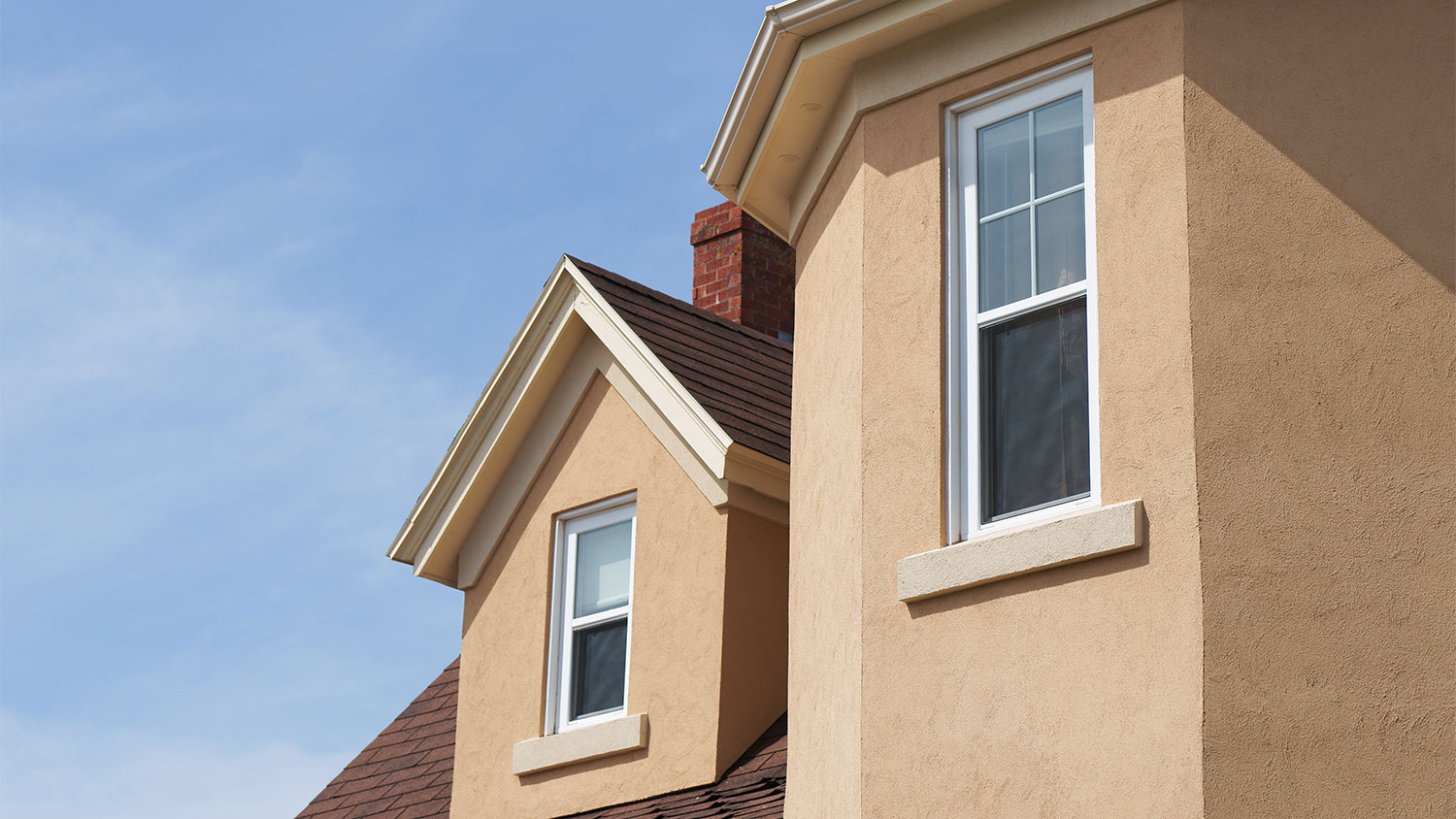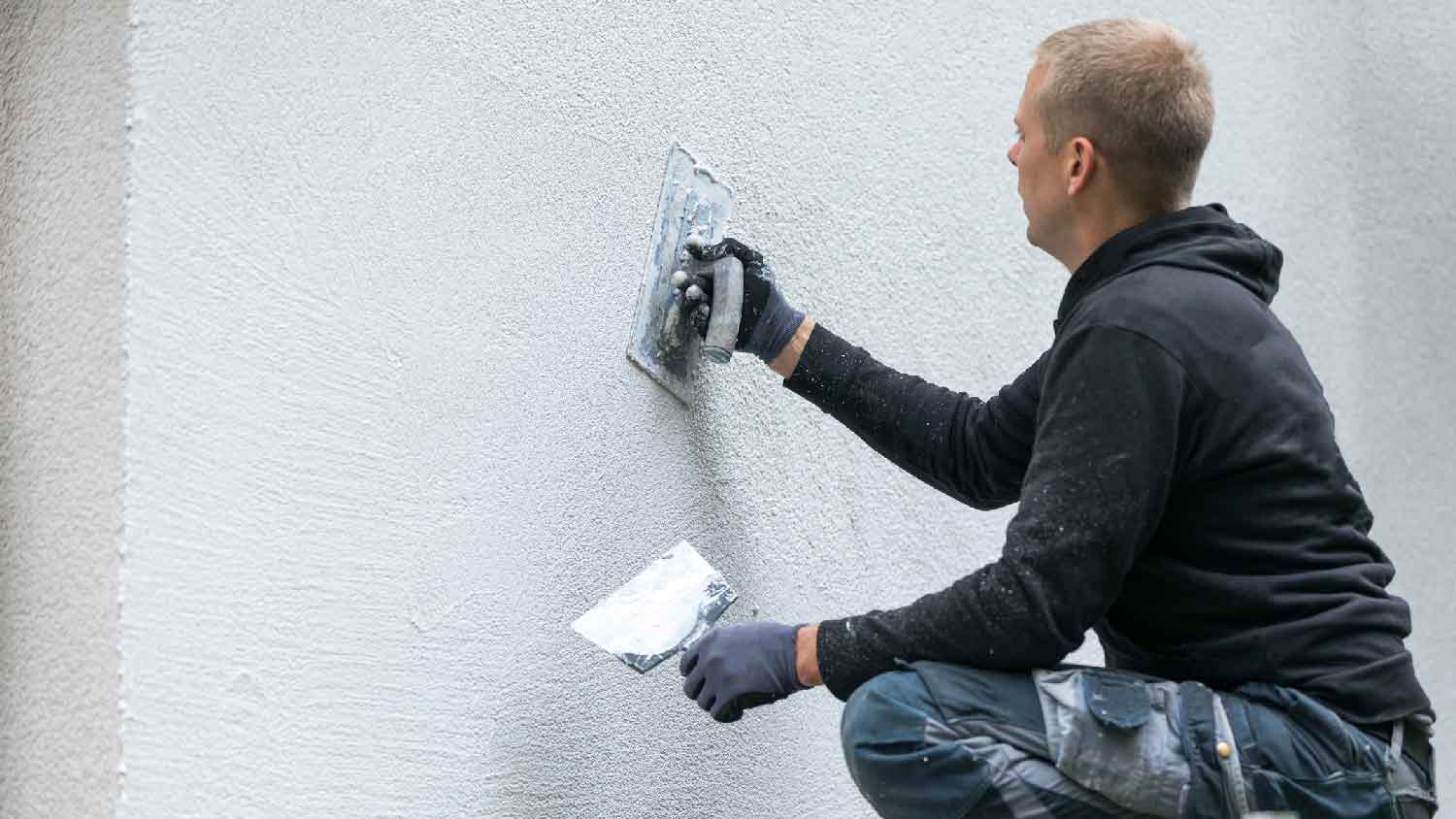
Discover the cost to stucco a house in 2025, including average prices, key factors, and tips to help you budget and plan your stucco project with confidence.
Your stucco will stick it out for the long haul


What is stucco? Stucco is a tried and true material with unique aesthetics that many homeowners prefer. It's durable, resilient, and can last up to 70 years with the proper care. It’s ideal for warmer weather climates as stucco isn’t as strong at insulating against the cold compared to other materials. Ultimately though, if you live in a region with plenty of sunlight, stucco really only needs a deep clean with a pressure washer 1-2 times every year and regular hose-downs to keep it looking like new. Below are some stucco maintenance tips to keep your exterior looking fresh.
Stucco is a porous material that can absorb stains from dirt, rain, and other environmental factors. To keep dirt and stains at bay, you should wash stucco siding two to three times a year (depending on how much debris and weather your home is exposed to).
It can take some elbow grease to clean stucco siding. Here are some stucco cleaning methods:
Spray off dirt: Start by spraying the stucco with your garden hose to loosen up dirt and stains. Then turn up the water pressure and spray it again from top to bottom.
Scrub stains: Examine the stucco for any lingering stains or build-up, then scrub it with a bristle brush.
Rinse it: After allowing sufficient time for the siding to dry, finish up by rinsing the stucco surface one last time.
If your stucco has tougher stains, such as mold or stubborn spots, you can use cleaning agents to help remove these stains.
Dish soap: Mix quality dish soap with warm water to clean dust and debris on your stucco walls.
Bleach: Bleach solution can be a great cleaner for mold and mildew stains on your stucco wall. Use it for spot treatment to remove more stubborn stains.
TSP solution (trisodium phosphate): This powerful chemical solution works for heavy-duty stucco cleaning and prepping walls for paint.
Safety tip: When using TSP, you should take the proper precautions. Wear safety gear (rubber gloves, protective eyewear, and long-sleeve clothing) and work in a well-ventilated area. Be sure to follow the manufacturing manual.
Always test the solution on a small area of your stucco before using it on the whole wall to see how it reacts and if it harms the color in any way.
Using a pressure washer to clean your stucco siding is faster and easier than using a garden hose. Power between 1,500 psi and 2,800 psi will remove stains and build-up dirt from stucco surfaces. But use caution, as improper use—using a power higher than 2,800 psi or being too close to the wall—can cause injury or damage to your stucco surfaces.
To avoid causing damage to the wall, use a nozzle at a 40-degree angle and stand 12 to 24 inches away from the wall you want to clean. You can also use a small nozzle at 25 degrees, but you gotta stand further away from the wall.
Safety tip: If you're not familiar with using the pressure washer, wear safety gear such as eye and ear protection to prevent injury.
You can also hire a pressure washing professional familiar with the proper settings to do the job safely.
You should do a basic inspection of your stucco every year. As stucco gets old, it can get cracks, holes, and chips that are not only unsightly, but compromise integrity. These cracks are the perfect place for mold and mildew to grow, and unfortunately, the cracks will grow larger if you don’t fix them. If you didn't look up how to drill into stucco before adding outdoor fixtures to your home, you may need to do some repair work to undo the damage.
Failure to spot and fix this damage could result in mold growing underneath your stucco, which could then start to show on the interior of your home. If mold growth continues, you’ll need to completely remove any affected surface (exterior or interior) and replace it with new stucco. If you live in a wetter climate, consider inspecting your stucco multiple times throughout the year for potential new damage.

Like any material, stucco can crack or break over time. As part of your regular maintenance, you should repair small cracks before they become bigger repairs. The most common stucco repairs you’ll run in to include:
Small cracks or chips: Hairline cracks in stucco are typically not a cause for concern, as this is a natural part of a foundation settling. Repairing stucco cracks that are smaller than ⅛ inch wide can usually be done yourself with a trip to the hardware store. Anything greater than that consider calling a stucco repair company.
Indented patches: If you notice any part of your stucco looks concave, call a pro immediately. This is usually a sign of water getting trapped underneath the stucco.
Crumbling or peeling: If you notice medium to large pieces of your stucco starting to peel off (think anything bigger than your hand), it’s time to call a pro. Water damage, pests, or general age are some of the reasons this could be happening, but left untreated it will only get worse.
Channeling water away: Over time, water damage can eat away at stucco and cause more cracks. Future-proof your house by upgrading your gutters to keep large puddles from pooling.
Refreshing paint: While not a time-sensitive “repair,” you’ll also need to refresh the paint job on your stucco after filling in a crack or making some of these repairs.
If your house is older, consider applying elastomeric paint. It's flexible, waterproof, and thick enough to cover hairline cracks. Elastomeric coating protects cracks for up to 10 years, even as they grow.
If you find larger or growing cracks, you may wonder—do you DIY or hire a stucco repair professional instead? It’s best to err on the side of caution and call in a pro.
Sealant should have been applied to your stucco after its initial application. Typically, professionals will use a clear masonry sealer to penetrate the stucco pores and prevent any water entering when stucco is first installed. For older stucco that you want to reseal, waterproof elastomeric paints are typically used.
You only need to seal stucco once every 5-10 years, depending on the climate, age of your existing stucco, and what products were used before. You should repair any cracks, chips, or other damage before applying sealant as this could result in worsening the existing damage or making your sealant less effective.

While regular stucco maintenance will help protect it from fading, over time, you may need to paint your house to refresh the stucco color. You should only use paint that is graded for exterior use (typically labeled as “acrylic,” “elastomeric,” or “masonry” paint), as any other paint will fade or chip away faster. This paint can also act as a sealant, which provides double duty as a fresh color and long-term protection.
Here are a few stucco painting tips to get great results:
Clean the surface: Before repainting your stucco siding, always clean the surface thoroughly to make sure the paint sticks to the stucco.
Prime it: To provide strength and flexibility, use primers and paints designed for stucco applications, such as urethane and acrylic resin.
To avoid paint failure: Use proper painting and prepping techniques and follow the manufacturer's recommendations for painting at the right temperature and humidity.
Replacement could be necessary if your stucco issues are caused by stucco failure. Failure generally results from defective installation. Signs that you're experiencing stucco failure that can only be solved with stucco replacement include:
Leaks within the stucco siding
Shrunken, dried, or missing caulk that indicates water or air intrusion
Rot near fixtures in the exterior wall
Heavy staining
Blackened stucco
Large cracks or bulging
Regardless of how much general stucco maintenance you do, untreated stucco failure puts a home at risk for rot and structural damage. Diagnosing stucco failure isn't a DIY task. In order to confirm failure, siding pros use semi-destructive and invasive testing to evaluate the condition of the stucco. Depending on the results, stucco repair pros will either recommend a full stucco replacement or provide a quote for stucco repair cost. When going over replacement options, stucco pros can also offer different price options by explaining synthetic stucco vs traditional stucco.
While a dedicated homeowner can learn how to repair stucco siding, the complexity of this task generally requires professional expertise. Stucco mixing is a delicate process that requires proper formulations and drying times. Improper stucco application or repairs can result in stucco failure that leaves a home vulnerable to mold, rot, and water damage. By hiring a local licensed stucco pro, you can be sure that the job will be done correctly to extend the life of your siding.
From average costs to expert advice, get all the answers you need to get your job done.

Discover the cost to stucco a house in 2025, including average prices, key factors, and tips to help you budget and plan your stucco project with confidence.

Get transparent stucco inspection cost info. Learn what impacts price, how to save, and what to expect before hiring a pro for your stucco inspection.

Discover the average stucco repair cost, key price factors, and ways to save. Get expert tips to budget your stucco repair project with confidence.

Stucco is a type of cement-based siding that’s durable, inexpensive, and designed to withstand the elements. Find out what makes it special, how much it will cost to install, and if it’s an addition that will be right for your home.

Fire-resistant siding can protect you and your home in the event of a wildfire. Learn if stucco is fire-resistant and how it compares to other materials.

Weigh the pros and cons of painting stucco—and estimate the final cost—before calling your local painter.